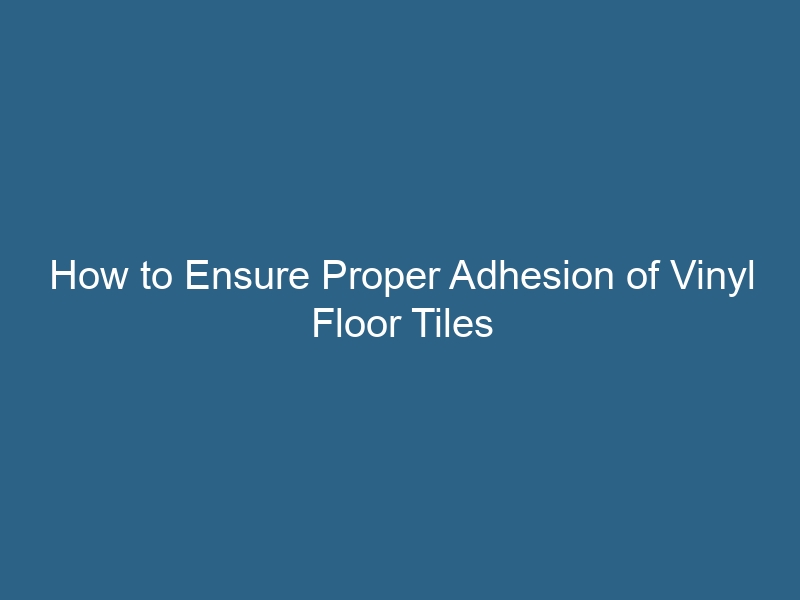Quck answer
If your vinyl floor tiles are not sticking properly, there are a few steps you can take to secure them:
1. Clean the surface: Remove any dirt, dust, or debris from the floor. Use a mild cleaner and a soft cloth or mop to ensure a clean surface.
2. Repair any damage: If there are any cracks or holes in the floor, fill them in with a vinyl floor repair kit. This will help create a smooth and even surface for the tiles to adhere to.
3. Use adhesive: Apply a vinyl floor adhesive to the back of the tiles using a notched trowel. Make sure to spread the adhesive evenly to ensure a strong bond.
4. Press down firmly: Once the adhesive is applied, firmly press down on the tiles to ensure they stick properly. Use a rolling pin or a weighted object to help with this process.
5. Allow time to dry: Give the adhesive enough time to dry and bond with the tiles. Follow the manufacturer’s instructions for drying time.
By following these steps, you can secure vinyl floor tiles that are not sticking and ensure a long-lasting and secure floor surface.
Vinyl floor tiles are known for their easy peel-and-stick installation. However, there may be instances where these tiles fail to stay in place. This can be due to issues with the installation process or the need for additional adhesive to secure the tiles.

Image Credit:
Kenny10/iStock/GettyImages
Basics of Vinyl Tile Installation
Typically, vinyl floor tiles come with a peel-and-stick style installation. They are already equipped with adhesive that is usually strong enough to keep them firmly in place. The tiles have a paper backing that covers the adhesive until you are ready to install them. Once you have determined the layout, you can peel off the backing of one tile at a time and press it onto the floor.
Potential Issues with Tiles
So, what causes vinyl tiles to not stick properly? There could be problems related to the environment or the installation process itself. Let’s start with the underlayment for vinyl tiles. These tiles can be installed over most existing flooring surfaces or underlayments, as long as the surface is flat, level, and dry. If the surface is not prepared properly, the tiles may crack or come loose. Using a leveling compound can help create a level surface and cover any gaps or cracks in the existing flooring.
Other issues may arise from the tiles or the environment. Vinyl expands and contracts with changes in temperature. If you bring the tiles from a cold garage into a warm home and immediately install them, you may encounter shifting problems. It is recommended to bring the tiles into the installation space at least 48 hours prior to installation to allow them to acclimate to the surroundings.
Always refer to the instructions provided with your specific product. Many vinyl flooring products specify a temperature range for installation. If you install the tiles when the room is too hot or too cold, it may affect the adhesive’s ability to bond properly. It is also important to ensure that the floor is dry and clean before you begin. Thoroughly sweep and clean the floor to remove any dirt or debris that can interfere with the adhesive’s strength. Allow the floor to dry completely before starting the tile installation.
Vinyl tiles require strong pressure to create a secure bond. If you install the tiles quickly without applying enough pressure, they may not bond properly. Using a floor roller can help ensure a strong bond. Additionally, be cautious when kneeling on newly installed tiles, as they may shift or slip, causing corners to lift. Placing plywood over the tiles can help distribute your weight and prevent tile shifting.
Ensuring Proper Adhesion of Vinyl Tiles
If you encounter issues with tiles not sticking during the initial stages of installation, pause to review the instructions and assess the working environment. It is always a good idea to test a few tiles and wait for an hour or so before starting a new tile project. This allows you to ensure that the adhesive is working effectively. You may need to make adjustments, such as using a leveling compound or repairing any damage to the existing floor. Additionally, you may need to wait until the temperature in the space is suitable for installation.
If you are still experiencing difficulties with the tiles adhering, you can try using a separate adhesive specifically designed for vinyl tiles. Follow the instructions on the packaging to apply the adhesive only in areas where the tiles are not sticking. Be careful not to apply too much adhesive, as it may overflow and create a sticky mess on your new flooring. Promptly clean up any excess adhesive that spills onto the floor. If your vinyl tile installation continues to have issues, assess the conditions to ensure they are suitable for proper adhesion. You can apply a small amount of adhesive to address any tiles that are still coming off the floor.


